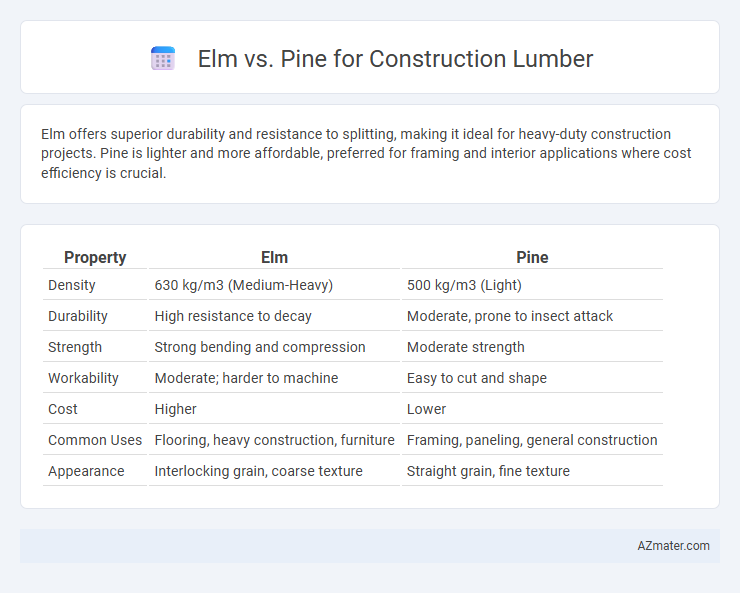Elm offers superior durability and resistance to splitting, making it ideal for heavy-duty construction projects. Pine is lighter and more affordable, preferred for framing and interior applications where cost efficiency is crucial.
Table of Comparison
| Property | Elm | Pine |
|---|---|---|
| Density | 630 kg/m3 (Medium-Heavy) | 500 kg/m3 (Light) |
| Durability | High resistance to decay | Moderate, prone to insect attack |
| Strength | Strong bending and compression | Moderate strength |
| Workability | Moderate; harder to machine | Easy to cut and shape |
| Cost | Higher | Lower |
| Common Uses | Flooring, heavy construction, furniture | Framing, paneling, general construction |
| Appearance | Interlocking grain, coarse texture | Straight grain, fine texture |
Overview: Elm and Pine as Construction Lumber
Elm offers superior durability and resistance to splitting, making it ideal for heavy structural applications in construction lumber. Pine is widely favored for its ease of workability, fast growth rate, and cost-effectiveness, commonly used in framing and general construction. Both woods provide specific advantages, with elm excelling in strength and pine being more accessible and lightweight for versatile building needs.
Botanical Characteristics of Elm and Pine
Elm trees (genus Ulmus) exhibit broad, serrated, and asymmetrical leaves with a characteristic interlocking grain that enhances resistance to splitting, making elm lumber durable for construction applications. Pine trees (genus Pinus) feature needle-like leaves in clusters and possess a straight grain with relatively low density, resulting in lightweight lumber that is easy to work with but less resistant to mechanical stress. Both species offer unique botanical traits that influence their structural performance and suitability in building projects.
Strength and Durability Comparison
Elm offers superior strength and natural resistance to splitting, making it highly durable for structural applications in construction lumber. Pine, while more commonly used due to its availability and cost-effectiveness, generally exhibits lower density and strength compared to elm, leading to faster wear under heavy loads. Elm's interlocking grain structure enhances its toughness and resistance to warping, providing longer-lasting performance in demanding building projects.
Workability and Machining Properties
Elm offers excellent workability due to its interlocked grain, providing good resistance to splitting and making it ideal for furniture and flooring. Pine is softer and easier to machine, allowing for faster cutting and shaping, though it may dent or splinter more readily under heavy use. Both woods perform well in construction lumber, but pine's ease of machining suits projects requiring extensive shaping, while elm's durability benefits structural applications needing toughness.
Resistance to Decay and Insects
Elm lumber exhibits moderate resistance to decay and insect attacks due to its dense grain structure and natural tannins, making it a durable option for construction. Pine, while widely used for framing, generally has lower natural resistance to decay and insects but can be treated with preservatives to enhance durability. Choosing between elm and pine for construction lumber depends on whether natural resistance or cost-effectiveness with treatment is prioritized.
Availability and Sustainability
Elm lumber is less readily available than pine due to elm tree populations being affected by Dutch elm disease, which restricts widespread harvesting. Pine is abundant and fast-growing, making it a more sustainable choice with quicker regeneration cycles and extensive plantation management supporting its availability. Sustainable forestry certifications like FSC are more commonly associated with pine, ensuring responsible sourcing and minimal environmental impact compared to the limited and often older-growth elm supplies.
Cost and Economic Factors
Elm lumber typically costs more than pine due to its density, durability, and natural resistance to wear, making it a preferred choice for heavy-duty construction projects requiring longevity. Pine, being a fast-growing softwood, is more economically viable for large-scale construction, offering lower initial costs and easier availability. For budget-conscious projects, pine provides a cost-effective solution, while elm's higher price reflects its superior strength and extended lifespan.
Typical Uses in Construction
Elm wood is prized in construction for its exceptional resistance to splitting and strong interlocking grain, making it ideal for bentwood applications, furniture frames, and flooring. Pine, being lightweight and easy to work with, is commonly used for framing, paneling, and general structural elements where moderate strength and affordability are priorities. Both woods serve distinct roles, with elm favored for durability and aesthetics, and pine chosen for versatility and cost-effectiveness in construction projects.
Environmental Impact and Eco-Friendliness
Elm wood, known for its durability and resistance to decay, generally requires less chemical treatment compared to Pine, making it a more environmentally friendly option for construction lumber. Pine, while fast-growing and widely available, often relies on intensive forestry practices and chemical preservatives that can pose ecological risks. Sustainable harvesting and certification programs like FSC play a critical role in minimizing the environmental impact of both Elm and Pine lumber in construction.
Choosing Between Elm and Pine for Your Project
Elm offers superior strength and durability with natural resistance to moisture, making it ideal for structural applications requiring long-lasting support. Pine is more affordable, lightweight, and easier to work with, suitable for projects where budget constraints and ease of handling are priorities. Selecting between elm and pine depends on the project's requirements for durability, cost, and handling efficiency.

Infographic: Elm vs Pine for Construction Lumber
 azmater.com
azmater.com